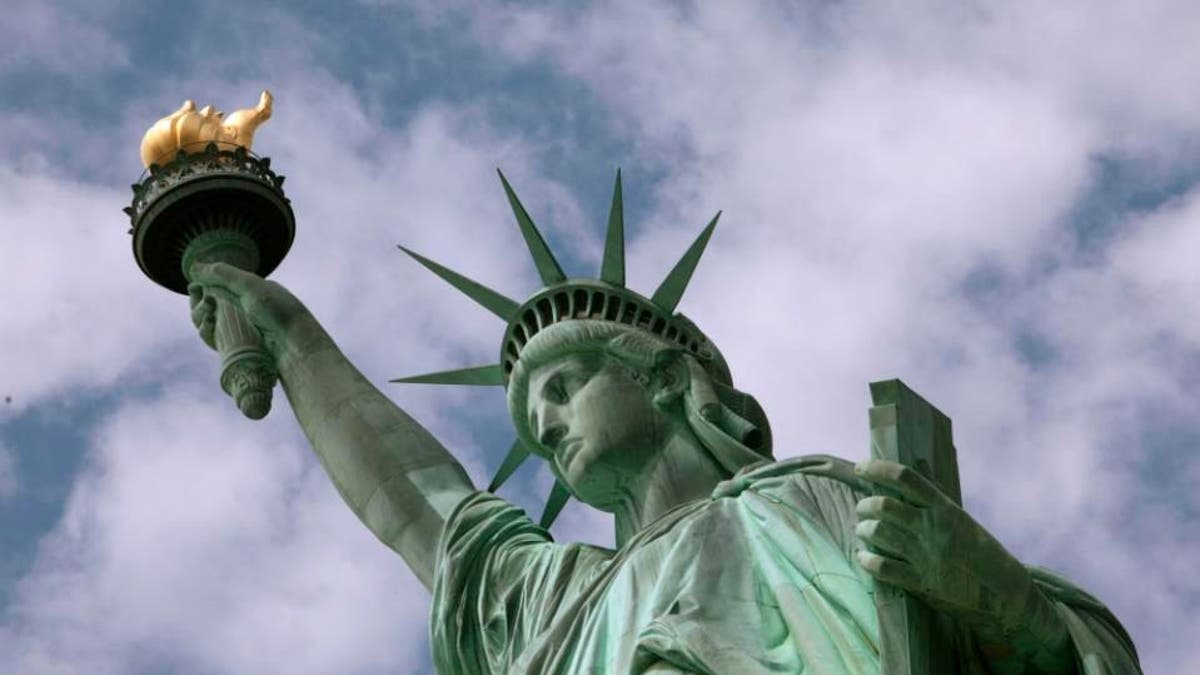Fox News Flash top headlines for July 3
Fox News Flash top headlines are here. Check out what's clicking on Foxnews.com.
The Statue of Liberty has been known for more than a century as one of the most preeminent symbols of American freedom – but now a Washington Post writer appears to be making the statue another target of cancel culture.
Philip Kennicott, an art and architecture critic who won a Pulitzer Prize in 2013, argues in an essay published Saturday that Lady Liberty stands for "hypocrisy and unfilled promises."
Kennicott’s piece, titled, "Maybe it’s time to admit that the Statue of Liberty has never quite measured up," was accompanied by an illustration of the famous statue resting on someone’s fingertip – as if the statue were only a fraction of an inch tall instead of 151 feet (305 feet including the base).
In arguing that the statue in New York Harbor has grown irrelevant, Kennicott uses as evidence the fact that he spotted no representations of the statue when he visited a Chicano art exhibit at the Smithsonian American Art Museum in Washington.
OLD GWEN BERRY PHOTO OF HER HOLDING AMERICAN FLAG GOES VIRAL AMID ANTHEM UPROAR
He concludes from that one example that although the statue is as "familiar to some Americans as the flag, the statue is just as meaningless or foreign to others, a sign without significance, or worse, a symbol of hypocrisy or unfulfilled promises."
Later, he argues that the statue has meaning mostly for descendants of European immigrants and less so for Americans whose families originate from other parts of the globe.

The Statue of Liberty is seen in New York Harbor, June 2, 2009. (Associated Press)
"I was looking at a Black newspaper from 1915," Kennicott quotes Lonnie G. Bunch III, secretary of the Smithsonian and founding director of the National Museum of African American History and Culture, as saying in a recent telephone interview.
"It said that while everybody was excited by the statue, it has turned its back on America," Bunch added, according to Kennicott.
The statue attracted more than 4 million visitors each year in 2014, 2015 and 2016, the most recent years for which figures are available on the National Park Service website. There is no breakdown of where the visitors were from.
STATUE OF LIBERTY'S ‘LITTLE SISTER’ ARRIVES IN UNITED STATES FROM FRANCE IN TIME FOR FOURTH OF JULY
Kennicott notes there have been high points in Lady Liberty’s popularity as a globally known beacon of freedom – such as when President Ronald Reagan celebrated the statue during his time in office and when "she served as a marker of resilience for New Yorkers scarred by the attacks of Sept. 11, 2001."

In this photo provided by the National Park Service, workers on Liberty Island install sod around the national monument in New York City, June 26, 2013. (Associated Press)
Replica statue
His essay asserting that the current moment is a low point for the statue appears inspired by the recent news that Philippe Étienne, the French ambassador to the United States, on July 14 will oversee the installation of a nine-foot bronze reproduction of the original Lady Liberty on the grounds of France’s diplomatic residence in Washington.
Although he quotes Étienne as saying Lady Liberty remains "a powerful symbol of the friendship between the French and American people -- and, of course, of the ideas of liberty and freedom, which are always fragile," Kennicott chooses to focus on the fragility rather than on the ideals.
"Indeed," he writes, "if the statue has had any kind of stable meaning over its lifetime, it is not as a symbol of liberty, but as a symbol of the misuse of liberty — as a hollow promise, unequally distributed and limited in its application to certain groups."
He then claims that’s why he saw no images of Lady Liberty at the Chicano art exhibition.
Later, he notes that one of the "ironies" of the statue is that Liberty "was depicted as a woman, at a time when women didn’t have the right to vote." He also notes that the statue took its place in New York Harbor not long after the U.S. passed the Chinese Exclusion Act, noting that the statue’s base was constructed in part by Chinese laborers.
Another irony, he notes: France, which gave Lady Liberty to the U.S., has no statue of its own that symbolizes a welcome to outsiders, he writes.
CLICK HERE TO GET THE FOX NEWS APP
Then he concludes: "But it’s debatable if America does, either. The noble sentiments of the poem by Emma Lazarus — "give me your tired, your poor, your huddled masses yearning to breathe free" — were all but effaced in the past four years of strident and often violent anti-immigrant sentiment."
Twitter users respond
Some Twitter uses weren’t buying Kennicott’s arguments.
"Last month I visited the island to see Liberty," one user wrote. "My white family was in the minority; the majority seemed to be from all over the world. Non white families were generously represented, many in non western attire. I heard many languages. The world still loves Liberty."
"You know Phil," another commenter wrote to the author, "it’s not what you say, it’s the way you say it. Why do you always have to be such a snobbish little scold? Nobody and nothing is ever good enough for your super-elevated standards. You’re just so consistently an annoying d---."

